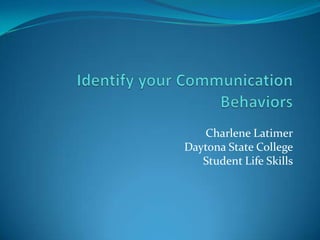
Improve Your Communication Skills
- 1. Charlene Latimer Daytona State College Student Life Skills
- 2. Communication Activity Snowflake Activity Take a piece of paper Please close your eyes Listen and follow directions You cannot ask any questions while doing this exercise Open your eyes Open up your paper and share it with the people near you. What did you learn about communication?
- 3. Purpose of Workshop Understand how your communication style is interpreted by others in order to avoid miscommunications and misunderstandings.
- 4. Communication is like an iceberg 7% - Words are the tip of the iceberg. Most visible and accounts for least. 23% - Non-verbal (facial expressions, tone of voice, etc.) 70% - Behavior/Actions
- 5. Nonverbal Communication “The most important thing in communication is to hear what isn’t being said.” Peter Drucker What you’re doing speaks so loudly I can’t hear what you’re saying.” Anonymous Nonverbal communication is powerful in any language or culture. For example: A smile is universally understood.
- 6. Non-Verbal Communication “Speaking” without words Giving or exchanging information without words. Non-verbal cues can reveal more about us than the words we speak. Forms of non-verbal communication: Voice, Personal Space and Body Language Take the Body Language Quiz
- 7. Interpersonal communication Most of us spend a large part of our day talking and hearing other people talk. This doesn’t make us great communicators. Effective communication is a process – an exchange of thoughts and feelings. Elements of communication Sender Receiver Channel Message/Context
- 8. Communication Quiz What’s your communication style? Take the communication quiz.
- 9. Three Modes of Communication Assertive Communication Aggressive Communication Passive Communication
- 10. Assertive Communication Stating your opinion How you feel What you want Direct, above-board, and civil manner Without violating the rights of others
- 11. Assertive Communicators Speak in calm, clear tone of voice Make good eye contact Have a relaxed, good posture
- 12. Aggressive Communication In an aggressive communication situation: Opinions Feelings and Wants are honestly stated at the expense of someone else’s feelings.
- 13. Aggressive communicators They use: Sarcasm Rhetorical questions Threats Profanity Negative labels YOU statements Finger pointing Hands on hips
- 14. Passive Communication In passive communication: Opinions, Feelings and Wants are withheld altogether or expressed only partially or indirectly.
- 15. Passive Communicators A passive communicator tends to: Speak softly or weak voice Have poor eye contact Posture is usually tense Difficulty accepting compliments Compare themselves unfavorably with others
- 16. Passive-Aggressive Communication In a passive-aggressive communication situation: Opinions, feelings and wants are expressed indirectly, can be manipulative and irresponsible. Unable to state emotions but determined to get their own way. Ex: Agree to a request but do everything possible to sabotage it.
- 17. What style of communication ? Continually pointing out others inadequacies. Put off any obligations by saying, “I forgot.” Put others on the defensive by degrading, trying to embarrass, and using anger. Accusing others of misunderstanding. Lack of Effort: uses “I can’t” which really means, “I won’t.”
- 18. Group Exercise Role play one style of communication: Assertive, Aggressive or Passive. What would you do? Participant choice of a situation.
- 19. Effective Communication Willingness to understand Active Listening Monitor your own communication Take the high road Count to ten What’s your strategy?
- 20. Speak with Authority & Clarity Be sincere and honest Be clear, accurate, and detailed Mean what you say and work hard to say what you mean Choose your words carefully Use examples to clarify your point Ask of feedback during the discussion Get to the point as quickly as possible Pay attention to other’s feelings and emotions
- 21. Speak with Authority & Clarity Make sure you emphasize your main points Respect others’ opinions Don’t use language that is threatening or demeaning to you or others Try to put other people at ease Remember the power of silence; force yourself to listen Cornerstones for Professionalism – Sherfield Moody
- 22. “The reason we have two ears and one mouth is so we can listen more and talk less.” Zeno, Greek Philosopher
- 23. Are You Sending the Right Message?
- 24. Just for Fun! “Always reserve your first comment for your own amusement.” “The real art of conversation is not only to say the right thing at the right place but to leave unsaid the wrong thing at the tempting moment.” Dorothy Nevill
